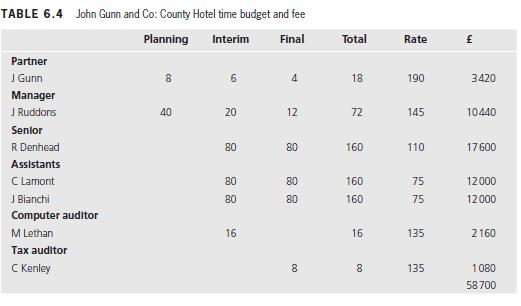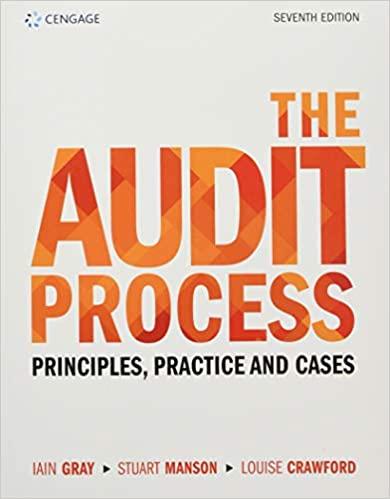In this question we are taking you through various scenarios and will ask you to perform a
Question:
In this question we are taking you through various scenarios and will ask you to perform a number of activities in a case study.
You are engaged in the audit of Fine Faces plc, a cosmetics company that manufactures and sells a range of lipsticks, deodorants, after-shave lotions and perfumes. The products are manufactured according to secret formulas that the company has developed over time.
Activity 1
Think about the nature of a cosmetics industry and then ask yourself what business risks would be faced by this kind of business.

We are sure you have seen that the cosmetics industry is in the fashion industry and that a major problem is the difficulty of assessing future fashion trends, so that what sold well in the past may not do so in the future. For the auditor this can be problematic. At the extreme, if the company gets future fashion trends wrong, the whole company might be at risk of losing its going concern status.
Even if this risk does not exist, the auditor might be worried that the company has inventories on hand that will prove to be unsaleable.
Activity 2
Now that you have considered a major business risk associated with the industry in which Fine Faces is placed, think about controls the company might have in place to meet the risk of changes in fashion.
You should also decide what specific work the auditor might perform in respect of the control to make sure that control risk is minimized. Consider the information that the company may require.
The most obvious control that the company would introduce is market research to establish current fashion trends and to determine if planned company ranges are likely to go down well with a somewhat fickle public. The auditor would wish to find out from management how they conduct market research and how often. This might involve face to face interviews, questionnaires and soundings with fashion leaders, the results of which should be subjected to analysis by company staff and a record made of the decisions taken. As changes in fashion may happen quickly, the company would have to ensure that it is kept informed of trends. The auditor will determine that the process has been satisfactory and will examine the market research reports, minutes of market research committee meetings and directors’ minutes.
A review of the trade press might also reveal whether the company had got it right or not. You would also be influenced by how successful Fine Faces plc’s management had been in forecasting fashion trends in prior years and also if sales analysis enables them to determine trends. Remember that your prime objective is to determine if the control is working properly, with the objective of reducing control risk, but you might also be interested in advising management on critical matters.
At this stage, you are aware of the major business/
inherent risk and the main control in force.
However, being a good modern auditor you adopt an attitude of professional scepticism and ask management how they keep track of how well products are performing in the marketplace. You discover that the company prepares projections of sales and production at the beginning of the year, keeps monthly records of sales budgets per line and makes monthly comparisons of budgeted with actual sales. Auditors might in practice make a comparison themselves for planning purposes to decide if inherent risk is high and also to determine if controls in force are adequate. The audit programme might read: ‘Obtain the budgets for year to date and compare with actual sales’. Any significant discrepancy between the two might reveal timing differences (sales turning up later than expected or vice versa) but more seriously might reveal that the anticipated sales had failed to materialize.
Activity 3
Assume that you have discovered a serious discrepancy between projected and actual sales. One brand of lipstick shows projected sales of £500 000, but no actual sales. This would seem to suggest that a problem exists for both Fine Faces and the auditor. Obviously, you now have to decide what you would do. Make a list of the actions that you think might be appropriate.Your immediate reaction might have been to go to the chief accountant and raise the matter with him or her. However, one of the basic rules of auditing is to be sure of your ground before you take any matter further.
Here are some suggested procedures you might adopt:
1 Review the market research report again to confirm the company’s view that this particular type and colour of lipstick would achieve good sales in the current year.
2 Examine the production reports to confirm that the product has been put into production.
3 Take a look at the inventory records to confirm that the finished stock of this lipstick has been received in the stores.
4 Confirm that the inventory on hand agrees with the inventory records.
At this point you can go to the chief accountant with information that backs up your previous concern that one of the products might turn out to be unsaleable. When you raise the matter, it will be almost certain that the chief accountant already knows about it. You may be somewhat concerned that you have not been told about it, knowing that integrity of management is important to the auditor. However, at this point it will be important for you to discover the background to the problem and what action the company is intending to take.
Activity 4
Assume that the chief accountant, faced with the wealth of information you have obtained, tells you that the problem of the unsold stock had arisen because of a buying problem. The buyer had purchased inappropriate raw materials, but this had been compounded by the failure of the inspection process when the materials had been received. The result was that, during the production process, the finished product could not be produced to a satisfactory standard. The company had tried to rectify the problem by purchasing new raw materials, but by the time they had passed through the production process, their competitors had captured the market.
Bearing in mind that we are considering the risk that the auditor might draw wrong conclusions on the basis of audit work performed, what would concern you at this stage? What conclusions could you draw?The main concern would be that you had failed to detect the problems in the buying and receipt of goods areas of the company before you stumbled on it as the result of detection procedures in another part of your audit. There was, of course, failure also of company control systems in respect of purchasing and the inspection of goods on receipt. The worry would be whether this had implications for other production lines as well.
Audit actions as a result of identifying the control risks discussed above would be an expansion of audit procedures to ensure that detection risk was low, bearing in mind high inherent risk at the boundary (between the entity and the outside world) and the high control risk at the same boundary. Examples of procedures might include tests on quality of raw materials and finished goods, examination of correspondence between suppliers, customers and the entity. The extent of your tests would depend on your judgement as to whether the breakdown in controls was a one-off breakdown or something more serious.
Apart from the audit risk matter that we have discussed, we have also seen that the entity’s controls have failed to reduce the impact of an important business risk – that products manufactured will fail to meet the standard expected, thus ensuring that the company is failing to meet at least one of its objectives – an acceptable level of profitability. You have also discovered that management has failed to inform you of this important matter, so much so, that at the extreme you might wonder if you should seek reappointment as auditor. This means that we have come across another reason for adopting a business risk approach – to aid you in the decision as to whether you should accept or extend the appointment.
Step by Step Answer:

The Audit Process Principles Practice And Cases
ISBN: 9781473760189
7th Edition
Authors: Iain Gray, Louise Crawford, Stuart Manson




